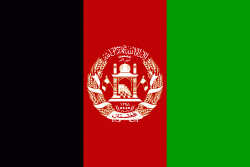Kama District (Kāmah)
Kama is a district in Nangarhar Province, Afghanistan, to the east of Jalalabad. Its population, which is 100% Pashtun, was estimated at 180,000 in 2012. The district is within the heartland of the Mohmand tribe of Pashtuns. The district centre is the village of Sanger Srye Kama. The districts includes most of the Kama Valley.
In 2008, The Provincial Reconstruction Team in Nangarhar province built a hospital in Kama district. This hospital will serve to the neighboring districts as well as possible. Moreover, Kama district has a number of Basic Health Clinics (BHCs), which provide services to the residents.
In 2008, The Provincial Reconstruction Team in Nangarhar province built a hospital in Kama district. This hospital will serve to the neighboring districts as well as possible. Moreover, Kama district has a number of Basic Health Clinics (BHCs), which provide services to the residents.
Map - Kama District (Kāmah)
Map
Country - Afghanistan
 |
 |
| Flag of Afghanistan | |
Human habitation in Afghanistan dates back to the Middle Paleolithic era, and the country's strategic location along the historic Silk Road has led it to being described, picturesquely, as the ‘roundabout of the ancient world’. Popularly referred to as the graveyard of empires, the land has historically been home to various peoples and has witnessed numerous military campaigns, including those by the Persians, Alexander the Great, the Maurya Empire, Arab Muslims, the Mongols, the British, the Soviet Union, and most recently by a US-led coalition. Afghanistan also served as the source from which the Greco-Bactrians and the Mughals, amongst others, rose to form major empires. The various conquests and periods in both the Iranian and Indian cultural spheres made the area a center for Zoroastrianism, Buddhism, Hinduism, and later Islam throughout history.
Currency / Language
| ISO | Currency | Symbol | Significant figures |
|---|---|---|---|
| AFN | Afghan afghani | Ø‹ | 2 |
| ISO | Language |
|---|---|
| PS | Pashto language |
| FA | Persian language |
| TK | Turkmen language |
| UZ | Uzbek language |















